ECD SYSTEM Turbocharger Oil Leak and White Smoke
| DTC Code | DTC Name |
|---|---|
| Turbocharger Oil Leak and White Smoke |
DESCRIPTION
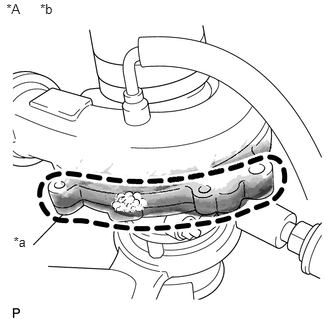
*A |
Fig. 4 |
*a |
In the case of an actual oil leak, oil leaks from the sealed part |
*b |
Oil Leak Check Point (FIPG Sealing Part) |
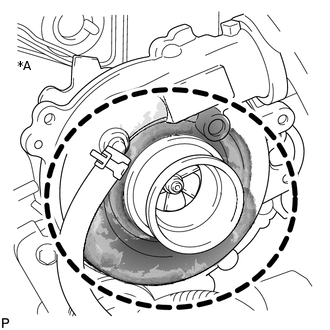
*A |
Fig. 1 |
Oil Leak Type |
Description |
Main Trouble Area |
|---|---|---|
Internal oil leak (White smoke) |
Oil leak from bearing housing to compressor housing (intake side) or turbine housing (exhaust side) through seal rings. An internal oil leak is not visible from outside of turbocharger sub-assembly. If an oil leak occurs from turbine side seal, large amount of white smoke will be emitted from exhaust pipe. |
|
External oil leak |
Oil leak from inside of turbocharger sub-assembly to outside of turbocharger sub-assembly (e.g. from FIPG seal, oil pipe flange or oil pipe union). Includes oil leak visible from outside of turbocharger sub-assembly. |
|
Turbocharger oil leaks are classified into 2 types. One is an internal oil leak, and the other is an external oil leak.
When oil leaks and smoke occur, the turbocharger sub-assembly may be mistakenly replaced, even though the turbocharger sub-assembly is not the cause of the problem.
When there are oil marks on the surface of the compressor housing, or oil in the compressor inlet or outlet, the problem may mistakenly be determined to be a turbocharger oil leak.
The parts of the turbocharger sub-assembly are shown in the following illustration.
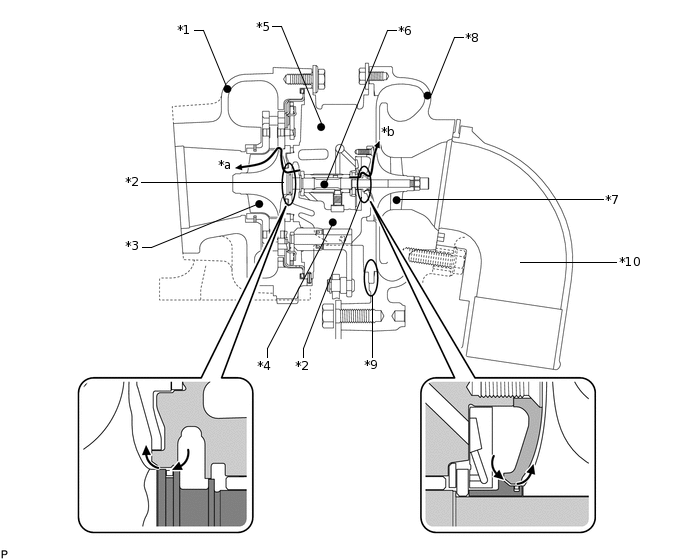
*1 |
Turbine Housing |
*2 |
Seal Ring |
*3 |
Turbine Wheel |
*4 |
Oil Drain (Outlet) |
*5 |
Bearing Housing |
*6 |
Turbine Shaft |
*7 |
Compressor Impeller |
*8 |
Compressor Housing |
*9 |
FIPG Sealing Part |
*10 |
Compressor Inlet |
*a |
Internal oil leak to turbine housing |
*b |
Internal oil leak to compressor housing |
This illustration is not the turbocharger sub-assembly of the 1AD-FTV engine.
If there is an oil stain similar to the one shown in the illustration (fig. 1) on the turbocharger sub-assembly, it may be oil spray from parts surrounding the turbocharger sub-assembly or oil leaking from the air cleaner hose. Therefore, this kind of oil stain on the outer surface of the turbocharger sub-assembly is not caused by an oil leak from the turbocharger sub-assembly (external oil leak), and is not related to white smoke. For identification of an actual turbocharger sub-assembly outer oil leak, check only the sealing part shown in the following illustration.
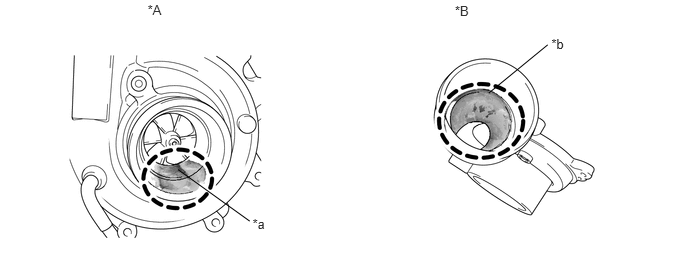
*A |
Fig. 2 |
*B |
Fig. 3 |
*a |
Oil Existence at Compressor Inlet (Max. 5cm3) |
*b |
Oil Existence at Compressor Outlet |
This illustration is not the turbocharger sub-assembly of the 1AD-FTV engine.
A certain amount of oil exists in the intake system because blow-by gas containing oil mist is returned to the intake system by the PCV. Therefore, the oil amount at the compressor inlet shown in the left figure (fig. 2) is normal and not an oil leak from the turbocharger sub-assembly (internal oil leak). Oil at the compressor outlet as shown in fig. 3 is normal.
This illustration is not the turbocharger sub-assembly of the 1AD-FTV engine.
This is an illustration (fig. 4) of an air leak test performed by applying soapy water to the area of the leak. Bubbles indicate the leak point.
Faults and Symptoms of Turbocharger Parts
Table 2. Compressor Side Seal Ring Main fault
Seal ring breakage
Symptoms
Oil leaks to compressor housing
Excessive oil consumption
Note
In the case of compressor seal ring failure, a large amount of oil will be found between compressor outlet and intercooler assembly, and between intercooler assembly and intake manifold, but not found at compressor inlet.
If large amount of oil is found at the compressor inlet, it is not from the turbocharger and may indicate a problem in the PCV system.
Table 3. Turbine Side Seal Ring Main fault
Seal ring breakage
Symptoms
Oil leak to turbine housing
Large amount of white smoke from exhaust pipe
Excessive oil consumption
Note
In the case of turbine seal ring failure, a large amount of white smoke would be emitted continuously.
If white smoke is emitted only just after engine is started (and disappears later), or small amount of white smoke is emitted intermittently, it is not caused by the turbocharger sub-assembly. It is due to failure of other parts.
If wet oil is found at turbine inlet, it is not from turbocharger sub-assembly. It is due to problem in other parts.
Table 4. Bearing Housing (Oil Drain Clogging) Main fault
Oil drain clogged by coked oil
Symptoms
Large amount of white smoke from exhaust pipe
Tip:Oil coking is caused by insufficient oil maintenance.
If the oil drain is clogged by coked oil, oil cannot be drained smoothly, and it overflows from the bearing housing to the compressor housing and turbine housing. This results in a large amount of white smoke from the exhaust pipe.
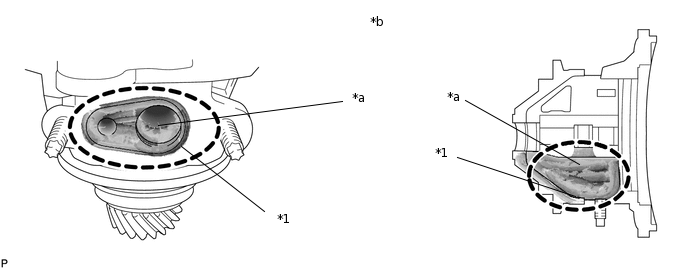
*1
Oil Drain
-
-
*a
Coked Oil
*b
Oil Drain Clogged with Coked Oil
Tip:This illustration is not the turbocharger sub-assembly of the 1AD-FTV engine.
Table 5. Turbine Shaft Main fault
Breakage
Seizure
Symptoms
Shaft does not rotate
Oil leak to compressor housing
Large amount of white smoke from exhaust pipe
Lack of power
Turbocharger noise changes
Note
In the case of turbine seal ring failure, large amount of white smoke would be emitted continuously.
If white smoke is emitted only just after engine start (and it disappears later), or small amount of white smoke is emitted intermittently, it is not from turbocharger sub-assembly. It is due to failure of other parts.
If wet oil is found at turbine inlet, it is not from turbocharger sub-assembly. It is due to problem in other parts.
Table 6. Compressor Impeller Main fault
Breakage
Symptoms
Shaft does not rotate
Oil leak to compressor housing
Lack of power
Note
In the case of compressor impeller failure, a large amount of oil will be found between the compressor outlet and intercooler assembly, and between the intercooler assembly and intake manifold, but not found at the compressor inlet.
Oil is blocked by boost pressure at compressor seal ring. Therefore, if boost pressure does not increase due to breakage of compressor impeller, oil flows out to compressor housing.
Table 7. Compressor Housing FIPG Sealing Part Symptoms
Oil leak from FIPG sealing part
Note
If an oil stain is separated by FIPG sealing part, it can be determined to be due to oil spray from other parts surrounding turbocharger sub-assembly.
If an oil stain is traced to a hose connection part, it can be determined to be due to a hose connection failure.
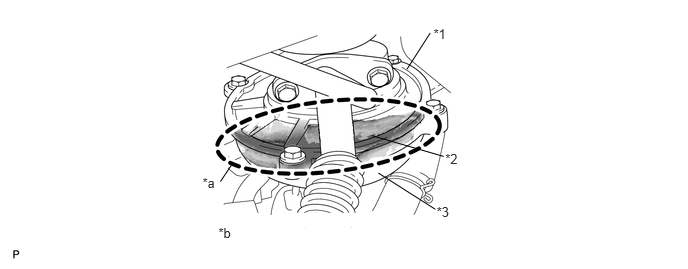
*1
Compressor Back Plate
*2
FIPG Sealing Part
*3
Compressor Housing
-
-
*a
Oil Leak
*b
Oil Leak from FIPG Sealing Part
This illustration is not the turbocharger of the 1AD-FTV engine.
Symptoms |
Oil leak from the hose connection between the hose and compressor housing |
Note |
If an oil stain is traced to an hose connection part, it can be determined to be due to hose connection failure. |
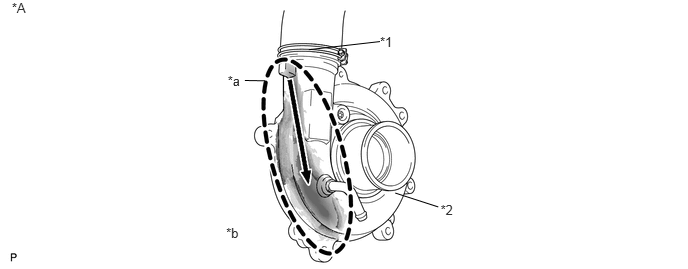
*A |
Fig. 5 |
- |
- |
*1 |
Compressor Outlet |
*2 |
Compressor Housing |
*a |
Trance of Oil Leak from Hose Connection Part |
*b |
Oil Leak from Hose Connection Part |
This illustration is not the turbocharger sub-assembly of the 1AD-FTV engine.
PROCEDURE
CHECK TYPE OF OIL LEAK
Check whether the oil leak is an internal or external oil leak.
Tip:White smoke is not related to an external oil leak.
Oil Leak Type
Description
Internal oil leak
(white smoke)
Oil leak from bearing housing to compressor housing (intake side) or turbine housing (exhaust side) through the seal rings.
Internal oil leak is not visible from the outside of the turbocharger sub-assembly.
If an oil leak occurs from turbine side seal, a large amount of white smoke will be emitted from exhaust pipe.
External oil leak
Oil leak from inside of turbocharger sub-assembly to the outside of the turbocharger sub-assembly (e.g. from the FIPG seal, oil pipe flange or oil pipe union).
Includes oil leaks visible from outside of the turbocharger sub-assembly.
Result
Result
Proceed to
External oil leak
A
Internal oil leak
B
B CHECK WHITE SMOKEClick here
REPLACE THE PART WHICH IS LEAKING OIL
Replace the part which is leaking oil.
Result
Proceed to
NEXT
NEXT END
CHECK WHITE SMOKE
Fully depress the accelerator pedal, and then release it.
-
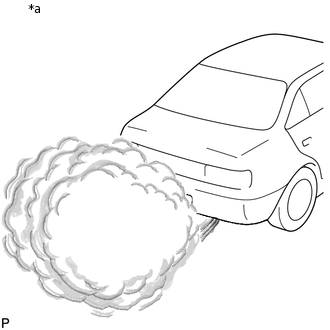
*a
Example
Check whether white smoke is emitted or not when racing the engine.
CAUTION:Be sure not to check for white smoke indoors.
Result
Result
Proceed to
White smoke is emitted
A
White smoke is not emitted
B
Tip:If white smoke appears for only a short period of time immediately after the engine is started, the white smoke is not from the turbocharger sub-assembly.
If the turbocharger sub-assembly is the cause of the problem, regardless of whether the engine is cold or warmed up, there will be a large amount of white smoke emitted to the extent that visibility will obstructed for a few meters by the smoke (as shown in the illustration).
Depending on whether there is oil mixed with the fuel, or whether there is unburned fuel present, the smell of the exhaust gas differs. When oil is mixed in, the exhaust gas smells like burning oil.
INSPECT COMPRESSOR INLET
Remove the air cleaner hose from the compressor inlet.
Check whether an excessive amount of oil is present or not, and whether excessive oil deposits are attached to the compressor impeller or not.
Tip:A certain amount of oil may be present as shown in fig. 2 in "Description", because a certain amount of oil mist is contained in the PCV gas and this oil accumulates just before the compressor inlet.
If an excessive amount of oil is present at the compressor inlet, there may be a problem in the PCV system.
Result
Proceed to
NEXT
INSPECT COMPRESSOR OUTLET
Remove the air hose from the compressor outlet.
Check whether or not an excessive amount of oil or excessive oil deposits are present at the compressor outlet.
Tip:A certain amount of oil may be present as shown in fig. 3 in "Description", because a certain amount of oil mist is contained in the PCV gas.
Result
Result
Proceed to
Excessive amount of oil present at both compressor inlet and outlet
A
Excessive amount of oil present only at compressor outlet
B
Excessive amount of oil not present at compressor inlet or outlet
C
INSPECT TURBINE INLET
Remove the turbocharger sub-assembly from the engine.
Check whether an excessive amount of wet oil or excessive oil deposits are present at the turbine inlet.
Tip:Be sure not to mistake carbon soot for oil.
Result
Proceed to
NEXT
INSPECT TURBINE OUTLET
Check whether an excessive amount of wet oil or excessive oil deposits are present at the turbine outlet.
Tip:Be sure not to mistake carbon soot for oil.
If the turbocharger shaft is tilted, some amount of oil will flow out from the bearing housing. Therefore, be sure not to mistake oil that flowed out from the bearing housing during or after the removal of the turbocharger sub-assembly for oil that was present before the removal of the turbocharger sub-assembly.
If an excessive amount of oil or excessive oil deposits are present at the turbine inlet, this oil is coming from the exhaust port of the cylinders, and may indicate a problem in 1 or more cylinders.
Result
Result
Proceed to
Excessive amount of oil present at both turbine inlet and outlet
A
Excessive amount of oil present only at turbine outlet
B
A CHECK ENGINE TO DETERMINE CAUSE OF OIL IN TURBOCHARGER SUB-ASSEMBLY
REPLACE TURBOCHARGER SUB-ASSEMBLY
Replace the turbocharger sub-assembly.
Result
Proceed to
NEXT
CONFIRM WHETHER MALFUNCTION HAS BEEN SUCCESSFULLY REPAIRED
Result
Proceed to
NEXT
NEXT END